Abstract
A new GIS based rainfall runoff model is developed for engineering applications, achieving a highly automated watershed analysis process starting from watershed delineation and up to the runoff hydrograph calculation. The model can be classified as a semi-distributed time area model that adopts an improved grid based approach for calculation of watershed response. The model deals with each grid cell in the digital elevation model as an independent hydrologic unit. Travel time through each grid cell is estimated using Manning’s formula and a stream power formula that relates the hydraulic radius at the cell to the characteristics of its upstream watershed area and excess rainfall depth. The watershed response at its outlet is estimated by routing the response of each grid cell using a flow path response function that is defined for that cell. The routed responses of all watershed cells are then convoluted to produce the outflow hydrograph. Model advantages include accuracy improvements due to the incorporation of grid-based routing calculations (both translation and attenuation), fully automated model structure, and fast ability to model many watersheds simultaneously. The combination of these advantages constitutes the novelty of the model that makes it very suitable for engineering design as well as for real-time applications. The model was tested using the data of the experimental watershed, Walnut Gulch, Arizona, USA, gauged by 88 rainfall stations and several discharge recording flumes. The results show that the model can accurately predict the runoff hydrograph where suitable input is available.







Similar content being viewed by others
References
Ajward MH, Muzik I (2000) A spatially varied unit hydrograph model. J Environ Hydrol 8(7)
Awadallah AG, Saad H, Elmoustafa A, Hassan A (2016) Reliability assessment of water structures subject to data scarcity using the SCS-CN model. Hydrol Sci J 61:696–710
Chiang S, Tachikawa Y, Takara K (2004) Rainfall-runoff simulation by using distributed instantaneous unit hydrograph derived from applying flow accumulation. Annual J Hydraul Eng JSCE 48:1–6
Clark CO (1945) Storage and unit hydrograph. Trans Am Soc Civ Eng 110:1419–1488
ESRI (2006) ArcGIS Desktop software, Release 9.1. Environmental Systems Research Institute, Redlands
Gad MA (2013) A useful automated rainfall-runoff model for engineering applications in semi-arid regions. Comput Geosci 52:443–452
Gad MA (2014) Flow velocity and travel time determination on grid basis using spatially varied hydraulic radius. Journal of Environmental Informatics 23(2):36–46
Kouwen N (1988) WATFLOOD: a micro-computer based flood forecasting system based on real-time weather radar. Canadian Water Resources Journal 13(1):62–77
Maidment D (1993) Developing a spatially distributed unit hydrograph by using GIS, HydroGIS 93. In: Kovar K, Nachtnebel HP (eds) publ. No 211. International Association of Scientific Hydrology, Wallingford
Maidment DR, Olivera JF, Calver A, Eatherall A, Fraczek W (1996) A unit hydrograph derived from a spatially distributed velocity field. Hydrol Process 10:831–844 John Wiley, New York
Moretti G, Montanari A (2007) AFFDEF: a spatially distributed grid based rainfall–runoff model for continuous time simulations of river discharge. Environ Model Softw 22(6):823–836
Olivera F, Maidment D (1999) Geographic information systems (GIS)-based spatially distributed model for runoff routing. Water Resour Res 35(4):1155–1164
Pilgrim DH, Chapman TG, Doran DG (1988) Problems of rainfall runoff modelling in arid and semi-arid regions. Hydrol Sci J 33(4):379–400
United States Department of Agriculture, USDA (1972) Hydrology. In: National Engineering Handbook. Soil Conservation Service (SCS), Washington, DC
United States Department of Agriculture, USDA (2007) Southwest watershed research center (SWRC) & walnut gulch experimental watershed (WGEW) brochure, Tucson
Wheater HS, Sorooshian S, Sharma KD (2008) Hydrological modelling in arid and semi-arid areas. Cambridge University Press, Cambridge
Author information
Authors and Affiliations
Corresponding author
Rights and permissions
About this article
Cite this article
Foda, R.F., Awadallah, A.G. & Gad, M.A. A Fast Semi Distributed Rainfall Runoff Model for Engineering Applications in Arid and Semi-Arid Regions. Water Resour Manage 31, 4941–4955 (2017). https://doi.org/10.1007/s11269-017-1787-2
Received:
Accepted:
Published:
Issue Date:
DOI: https://doi.org/10.1007/s11269-017-1787-2




